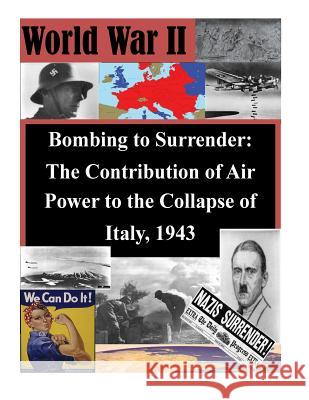Bombing to Surrender: The Contribution of Air Power to the Collapse of Italy, 1943 » książka
Bombing to Surrender: The Contribution of Air Power to the Collapse of Italy, 1943
ISBN-13: 9781500860141 / Angielski / Miękka / 2014 / 144 str.
Throughout this first century of air power, military theorists have proposed numerous schemes as the best use of air power. Airmen of many nations tried and tested these theories in wars large and small and they have learned, ignored, or forgotten many lessons. Of the four major coercive mechanisms available to air power punishment, risk, military denial and decapitation Robert Pape in Bombing to Win, concludes that military denial is the best use of air power. Furthermore, Pape argues that recent technological advances only enhance the military denial mechanism. In his appendix, Pape categorizes the Italian case as another case of successful military denial. This study examines the collapse of Italy in 1943 and the contribution of air power to this collapse. Several broad works, often citing Ernest May in Lessons from the Past, claim that air power decisively caused the Italian surrender, but do not indisputably argue this point or do they define the coercive mechanism air power employed to achieve this result. Studies such as the United States Strategic Bombing Survey or the British Bombing Survey Unit largely ignore Italy or in the case of F. W. Dakin The Brutal Friendship, cite the coalition politics as the primary cause of Italy's surrender. This book reveals how air power made four contributions to the collapse of Italy. First, airpower shaped the grand strategy of the western Allied powers in 1943. The Americans preferred to wage an air campaign to destroy German industry while using the direct approach of a cross channel invasion to defeat Germany. Under the leadership of Churchill, the strong British preference for an indirect strategy aimed at the soft-underbelly of Europe as well as the belief in the efficacy of air power to cause the Italian surrender through morale bombing artfully maneuvered the United States into waging a prolonged campaign in Africa and the Mediterranean. Second, mainland attacks against rail marshaling yards, ports and airfields did indirectly contribute militarily to operations HUSKY and AVALANCHE. The destruction of six key rail nodes was part of an over-all interactive campaign to prevent reinforcements and supplies from reaching first Sicily in support of HUSKY and then southern Italy in support of AVALANCHE. The San Lorenzo marshaling yards in Rome, however, was not one of these six key notes Additionally, in both HUSKY and AVALANCHE Allied forces enjoyed unprecedented air superiority, which resulted in the ability for strategic air power to pursue operations other than the direct or indirect support of ground operations'. Third, both American and British strategic bombing contributed to the psychological decapitation and fall of the Fascist government on July 25, 1943. In a meeting with Hitler on the nineteenth of July, Mussolini failed to obtain German military aid especially the desperately needed 2000 fighters. Significantly, the first air raid on Rome by over 540 bombers, the largest air raid in history to date, interrupted the meeting. This first raid also convinced the Italian king, a majority of Fascist leaders, and the Pope that Italy must get out of the war. A stunned Mussolini called for a meeting of his Grand Council of Fascism for 24 July, where he allowed, in the wee hours of the 25th, Fascist leaders to pass a motion to remove him from command of military forces. Later that day, the King, again in command of the army, arrested a docile, psychologically decapitated Mussolini in a bloodless coupdetat. Finally, air power coerced and aided the interim Badoglio government to surrender unconditionally and escape to the Allies on 9 September. Appointed by the king, Badoglio quickly sent civilian representatives to Lisbon to negotiate a conditional surrender to the Allies, despite the mounting German occupation of Italy. The threat and actual second Rome air raid resulted in the first direct contact between Badoglio's military representatives and the Allies in order to declare R
Zawartość książki może nie spełniać oczekiwań – reklamacje nie obejmują treści, która mogła nie być redakcyjnie ani merytorycznie opracowana.











